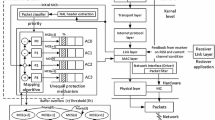Abstract
High-quality data traffic management providing ultra-low latency and less circuit complexity are the technical challenges for 5G cellular networks in recent years. To address the increased data rate traffic and enhance the user experience, buffer management with effective utilization of resources are 5G networks. The existing research contains uncompressed or raw video data transmission over a double buffer system. The spectrum is always busy with information if uncompressed data is sent. Transmission delays occur while packet transmission and receiver systems result in video buffering. The authors proposed an optimized resource framework in this research paper by compressing data using a modified H.265 Lagrangian Encoder and transmitting data using a single buffer technique. The transmission delays are mitigated, and data buffering is minimized with reduced transmission errors. The proposed method is tested and verified with various errors like collision error, propagation error, sensing error, and accuracy. The proposed model gives an improvement in accuracy when compared with the existing model.









Similar content being viewed by others
Data availability
This manuscript has no associated data.
References
Hussein HH, Elsayed HA, Abd El-kader SM (2020) Intensive benchmarking of D2D communication over 5G cellular networks: prototype, integrated features, challenges, and main applications. Wirel Netw 26:3183–3202
Liang L, Li GY, Xu W (2017) Resource allocation for D2D-enabled vehicular communications. IEEE Trans Commun 65(7):3186–3197
Burger V, Zinner T, Dinh-Xuan L, Wamser F, Tran-Gia P (2018) A generic approach to video buffer modeling using discrete-time analysis. ACM Trans Multimedia Comput Commun Applic (TOMM)s 14(2s):1–23
Roy A, Pachuau JL, Saha AK (2021) An overview of queuing delay and various delay based algorithms in networks. Computing 103(10):2361–2399
Bisdikian C, Lew JS, Tantawi AN (1996) The generalized D [X]/D/1 queue: A flexible computer communications model. Telecommun Syst 6:127–146
Islam S, Budati AK, Mohammad KH, Goyal SB, Raju D (2023) A multi-sensory real-time data transmission method with sustainable and robust 5G energy signals for smart cities. Sustain Energy Technol Assess 57:103278
Zhang P, Zhao L, Cheng B, Gao P (2022) Optimization of the quality-to-power ratio of scalable video code video transmission in millimeter-wave massive multiple-input multiple-output systems. Trans Emerg Telecommun Technol 33(1):e4379
Vivekananda GN, Reddy PC (2023) Efficient video transmission technique using clustering and optimisation algorithms in MANETs. Int J Adv Intell Paradigms 25(3–4):248–263
Ma C, Chung W (2022) Visual communication design based on collaborative wireless communication video transmission. J Sensors 2022:1–11
Zhang B, Cosman P, Milstein LB (2019) Energy optimization for wireless video transmission employing hybrid ARQ. IEEE Trans Veh Technol 68(6):5606–5617
Nie H, Jiang X, Tang W, Zhang S, Dou W (2020) Data security over wireless transmission for enterprise multimedia security with fountain codes. Multimedia Tools Appl 79:10781–10803
Ramesh S, Yaashuwanth C (2020) Enhanced approach using trust-based decision making for secured wireless streaming video sensor networks. Multimedia Tools Appl 79(15–16):10157–10176
Marinšek A, Van der Perre L (2021) Keeping up with the bits: tracking physical layer latency in millimeter-wave Wi-Fi networks. Netw Internet Arch. https://doi.org/10.48550/arXiv.2105.13147
O’shea T, Hoydis J (2017) An introduction to deep learning for the physical layer. IEEE Trans Cogn Commun Netw 3(4):563–575
Busari SA, Khan MA, Huq KMS, Mumtaz S, Rodriguez J (2019) Millimetre-wave massive MIMO for cellular vehicle-to-infrastructure communication. IET Intel Transp Syst 13(6):983–990
Wang J, Weitzen J, Bayat O, Sevindik V, Li M (2019) Interference coordination for millimeter wave communications in 5G networks for performance optimization. EURASIP J Wirel Commun Netw 2019:1–16
Mezzavilla M, Zhang M, Polese M, Ford R, Dutta S, Rangan S, Zorzi M (2018) End-to-end simulation of 5G mmWave networks. IEEE Commun Surv Tutorials 20(3):2237–2263
Shilpa B, Budati AK, Rao LK, Goyal SB (2022) Deep learning based optimised data transmission over 5G networks with Lagrangian encoder. Comput Electr Eng 102:108164
Fu Y, Wang S, Wang CX, Hong X, McLaughlin S (2018) Artificial intelligence to manage network traffic of 5G wireless networks. IEEE Network 32(6):58–64
Sepulcre M, Gonzalez-Martin M, Gozalvez J, Molina-Masegosa R, Coll-Perales B (2021) Analytical models of the performance of IEEE 802.11 p vehicle to vehicle communications. IEEE Trans Veh Technol 71(1):713–724
Golaghazadeh F, Coulombe S, Robert JM (2022) Residual packet loss rate analysis of 2-D parity forward error correction. Signal Process: Image Commun 102:116597
Tahir MN, Katz M (2022) Performance evaluation of IEEE 802.11 p, LTE and 5G in connected vehicles for cooperative awareness. Eng Rep 4(4):e12467
Li S, Li H, Gaber J, Yang S, Yang Q (2023) Performance Analysis of IEEE 802.11 p Protocol in IoV under Error-Prone Channel Conditions. Sec Commun Netw 2023:5476836. https://doi.org/10.1155/2023/5476836
Dou Z, Zhou X, Yang Q, Yang L, Tian J (2022) Improvement and performance evaluation of IEEE 802.11 p protocol in dense scenario of VANET. Mob Inf Syst 2022:1955948. https://doi.org/10.1155/2022/1955948
Funding
This research did not receive any specific grant from funding agencies in the public, commercial, or not-profit sectors.
Author information
Authors and Affiliations
Corresponding author
Ethics declarations
Conflict of interest
The authors have no conflicts of interest to declare that are relevant to the content of this article.
Additional information
Publisher's note
Springer Nature remains neutral with regard to jurisdictional claims in published maps and institutional affiliations.
Appendix
Rights and permissions
Springer Nature or its licensor (e.g. a society or other partner) holds exclusive rights to this article under a publishing agreement with the author(s) or other rightsholder(s); author self-archiving of the accepted manuscript version of this article is solely governed by the terms of such publishing agreement and applicable law.
About this article
Cite this article
Bagade, S., Kumar, B.A. & Rao, L.K. Efficient data transmission over 5G Networks with improved accuracy using 802.11p. Multimed Tools Appl 83, 40377–40392 (2024). https://doi.org/10.1007/s11042-023-17156-1
Received:
Revised:
Accepted:
Published:
Issue Date:
DOI: https://doi.org/10.1007/s11042-023-17156-1




